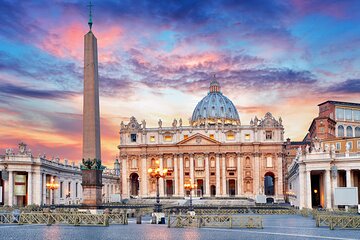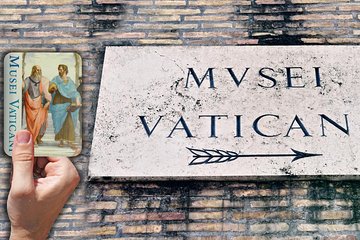9 of the Top Parks and Gardens in Rome

Editor's note: If you're traveling to Rome during the Rome Jubilee (Dec 24, 2024–Jan 6, 2026), expect heavier traffic and restorations on major landmarks. Plan in advance to avoid disappointment, and note that there may be some last-minute disruption to tour inclusions.
The relentless pace and busy traffic in Italy’s capital city can be overwhelming, and locals have been retreating to green spaces in Rome for a respite since ancient times. From sprawling parks crisscrossed with quiet walking paths to hidden gardens packed with seasonal blossoms, Rome has a wide variety of lush oases to explore. In addition to a relaxing stroll, you can rent a bike or rowboat, admire statuary and other open-air artworks, and take in sweeping views over the rooftops from Rome gardens. Discover the most beautiful parks in Rome for a nature-filled break with this breakdown of the city’s best.
1. Villa Borghese

This vast public park is among the most famous gardens in Rome.
Set in the heart of the city, Villa Borghese is Rome’s premier public park and home to a number of major attractions. Walk or cycle along the shaded paths past statues and fountains, row across the pretty lake, marvel at works by Bernini and Caravaggio at the excellent Borghese Gallery (Galleria Borghese) museum, and check out the menagerie at the Bioparco (Rome’s zoo). Make your way to the Pincio Garden (Pincio) terrace by sunset to take in views over Piazza del Popolo and the Historic Center of Rome (centro storico).
2. Villa Doria Pamphilj

One of the top parks in Rome, this private estate-turned-public green space is a lush retreat.
The former private estate of the noble Pamphilj family, Villa Doria Pamphilj is Rome’s largest park. It’s located just west of the Trastevere neighborhood and divided into three areas: the villa and gardens, the pine forest, and the agricultural estate. The villa and gardens are the headliners, with the 17th-century Casino del Bel Respiro surrounded by meticulously landscaped grounds with parterre, winding paths, a pedestrian bridge, and large shade trees ideal for keeping cool in Rome’s torrid heat.
3. The Botanical Garden (Orto Botanico)

A flower-filled paradise near all of the sights in Trastevere.
Though the Botanical Garden is an easy walk from the heart of Trastevere, it’s always refreshingly devoid of crowds and one of the most peaceful parks in Rome. Stretching over 30 acres (12 hectares), the grounds contain more than 3,000 species planted on its sloping hillside. Visitors can stroll through the bamboo forest, Japanese garden, and rose garden outdoors, plus pop into several indoor greenhouses to admire orchids, bonsai, cacti, and other blooms. At the top of the gardens, the Janiculum Hill (Gianicolo) overlook offers one of the best bird’s-eye views of the city.
4. The Vatican Gardens

Book a guided tour to marvel at the Pope’s private Renaissance gardens.
Accessible only with an official minibus tour, the Vatican Gardens see a fraction of the throngs that crowd the other Vatican City highlights. The 13th-century grounds are spread over 57 acres (23 hectares) behind St. Peter’s Basilica and the Vatican Museums. Open minibus tours take visitors through the landscaped terraces with flower beds and fountains while an on-board audio guide narrates their history and design in several languages. Vatican Gardens tickets also include admission to the Vatican Museums and Sistine Chapel.
5. The Orange Garden

Savor one of the best rooftop views over Rome from this fragrant public park.
The Orange Garden (Giardino degli Aranci) is one of the must-visit parks in Rome for romantic travelers seeking a sunset perch over the city. Officially named Savello Park, this scenic overlook sits on the Aventine Hill (Aventino) and is famous for its blossoming orange trees that give the garden its nickname. The best time of day to visit is at dusk, when locals and tourists gather along the parapet to take in views that stretch across the city to St. Peter’s Basilica Dome (Cupola di San Pietro).
6. The Rose Garden

Stop and smell the roses—more than 1,000 varieties—at this colorful spot overlooking Rome’s ancient heart.
No Rome parks guide would be complete without a mention of the city’s pocket-sized Rose Garden (Il Roseto), which sits above the ancient Roman Circus Maximus (Circo Massimo) and Palatine Hill (Palatino). About 1,200 varieties of roses bloom here each spring, including rare types like the green-petaled Rosa Chinensis Viridiflora and the Rosa Chinensis Mutabilis, which changes color during its blooming cycle. The garden is open seasonally from the end of April through mid-June.
7. Villa Ada

This former royal estate is now a sprawling and beloved local park fit for a king.
One of the top parks in Rome flies under the radar of most visitors, but is a favorite among Romans who gather here on fine days to picnic, jog, relax, and even enjoy live music and DJ sets during the summer Villa Ada Festival. Known as Villa Ada, the 395-acre (160-hectare) park’s full name is Villa Ada Savoia, a reference to its former life as a Savoy royal estate. Its pretty lake and leafy woods are an ideal spot to take a break from sightseeing in Rome, and gems like the ancient Catacombs of Priscilla and elegant Parioli neighborhood are nearby.
8. Villa Celimontana

Picnic at the base of an ancient Egyptian obelisk in this urban park near the Colosseum.
Bookended by the Colosseum to the north and the Baths of Caracalla to the south, Villa Celimontana surprises with its colorful blooms and leafy woods surrounded by urban bustle. One of the premier historic gardens in Rome, this 16th-century park sits on the Caelian Hill (Celio) and is home to a clutch of sculptures, fountains, and the Egyptian obelisk of Ramses II. Elegant Casino Mattei, the Renaissance villa that now houses the Italian Geographical Society, sits at the park’s heart.
9. Appian Way Regional Park

Follow the footsteps of the ancient Romans along the Appian Way just outside the city.
Now protected within the confines of a regional park, the Appian Way was the most important road in the Roman Empire. Its ancient footprint with the original paving stones and a smattering of villa ruins, aqueducts, and other archaeological treasures still stretches from the Aurelian Walls southwest to the Castelli Romani (the original road led all the way to Bari on Italy’s Adriatic coast). Explore the route on foot or by bike, stopping to admire highlights like the Catacombs of Priscilla, Catacombs of San Callisto, Catacombs of Domitilla, and Mausoleum of Cecilia Metella.
Find more things to do in Rome
Keep reading
































